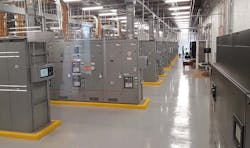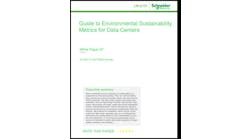ORLANDO -- At this month's 7x24 Exchange conference, Peter Panfil, challenged attendees to take a fresh look at every element of their data center power usage. “I think we, as an industry, have to embrace everything that helps us reduce the carbon cycle,” said Panfil, the Vice President of Global Power at Vertiv,
So how do we go about that process and where do we start? Panfil advocated for a holistic approach encompassing the lifecycle of the data center, working to reduce carbon, water, waste, and energy losses.
For carbon, we have the move to net zero carbon. He highlighted the efforts towards developing a new generation of power systems that will move to a hydrogen powered ecosystem. For water, the need to optimize water usage is clear, and a focus on developing new thermal configurations that improve water consumption and maximize efficient use of water within the data center.
An entire presentation could be done on dealing with waste issues. E-waste is a huge problem in our society overall, not just in the data center, and a renewed focus on upgradeability, refurbishing, and recycling. The circular econom, can have a significant impact on data centers, not just at the hyperscaler level, but also with smaller, and potentially more efficient businesses.
Energy was the primary focus of Panfil's presentation. Reducing power losses, improving efficiency, and ensuring system uptime are primary goals for any data center. How the industry goes about doing this will be driven not just by business need, but by market forces, many of which, such as those related to political viability, are outside the direct control of the data center operator.
Quoting Mark Hamilton of Cyxtera, Panfil echoed his sentiment - “I want to use as few watts as possible and I want each of those watts to be the most efficient and sustainable they can be.” The focus of the critical power infrastructure for the data center has to drive towards the most efficient power utilization possible, starting from how the power is generated to how it’s applied on-site. How does the industry move towards the greatest levels of sustainability, while remaining economically feasible and viable?
Taking Control of Your Power
Alternative power sources need to be found for data centers and Panfil is a big fan of hydrogen-sourced power. But beyond the new source, power will need to be used more efficiently. For that, Panfil says, the goal its to move to a dynamic online power mode, which has the benefit of high efficiency operation without the penalties assisted with economy mode operation.
One of the basics of that dynamic online power mode is the investment in a microgrid architecture, one that can stand on its own or be connected to the larger grid. With the dynamic power energy ecosystem micro grids can reduce vulnerability to utility outages and shortfalls. But it’s only part of that ecosystem which is backboned by a UPS that can act as a dynamic energy resource, providing power at any time, not just when backup power is required. That can be in addition to a battery energy storage system which can be the source of extended backup power or to provide the ability to deliver a utility style always on power source. A big reason that this type of power system is practical is the movement from lead-acid batteries to lithium batteries, with their greater overall efficiency, due to their longer lifespan, higher energy densities, and lower maintenance requirements, in the data center power role.
These options, and potentially others are connected to your microgrid as part of your energy ecosystem. Once you’ve moved to this model, it becomes possible to take advantage of techniques such as demand management, where you can take advantage of energy availability and energy cost. When demand is high, you can supplement your energy usage using previously stored energy, if necessary. With a sufficiently capable system you can adjust your energy consumption based on changes in energy prices or make use of different energy sources to provide both primary and secondary power sources for your data center.
It's a Process, and a Goal
Many data centers are already on the way to reducing their carbon footprint. Increased data center efficiency is where most facilities start. For colocation data centers this has meant investing in more efficient infrastructures, supporting higher rack densities, high efficiency cooling, and the availability of environmentally friendly energy sources, such as the various types of renewables.
When services go beyond pipes and power, the operational efficiencies that can be found can make the data center more carbon neutral. Server virtualization, high density servers, comprehensive orchestration systems, for both the infrastructure and the IT workloads, and using AI to optimize not just energy usage but things such as workload placement can all result in an increase in operational efficiency for the data center while reducing operational costs and decreasing the carbon footprint of the data center.
When building new data centers, the goal of a net zero carbon footprint needs to be baked in from the beginning. From the start of the supply chain to the completed data center, every aspect of the design and construction can have a net zero carbon focus. Each technology required to build a state-of-the-art facility is on it’s own path for sustainability and assuring that your build process takes advantage of changes every step of the way is critical in taking the high road to a sustainable infrastructure and facility.
From that point on, maintaining sustainability and allowing your data centers to operate in ways that meet your ESG demands requires staying aware of how changes to the technologies will impact your operational efficiencies and your overall functionality. Making that effort for the future may require an ongoing process of evaluating your infrastructure and operations. As that well known amphibian said, “it’s not easy being green.”







